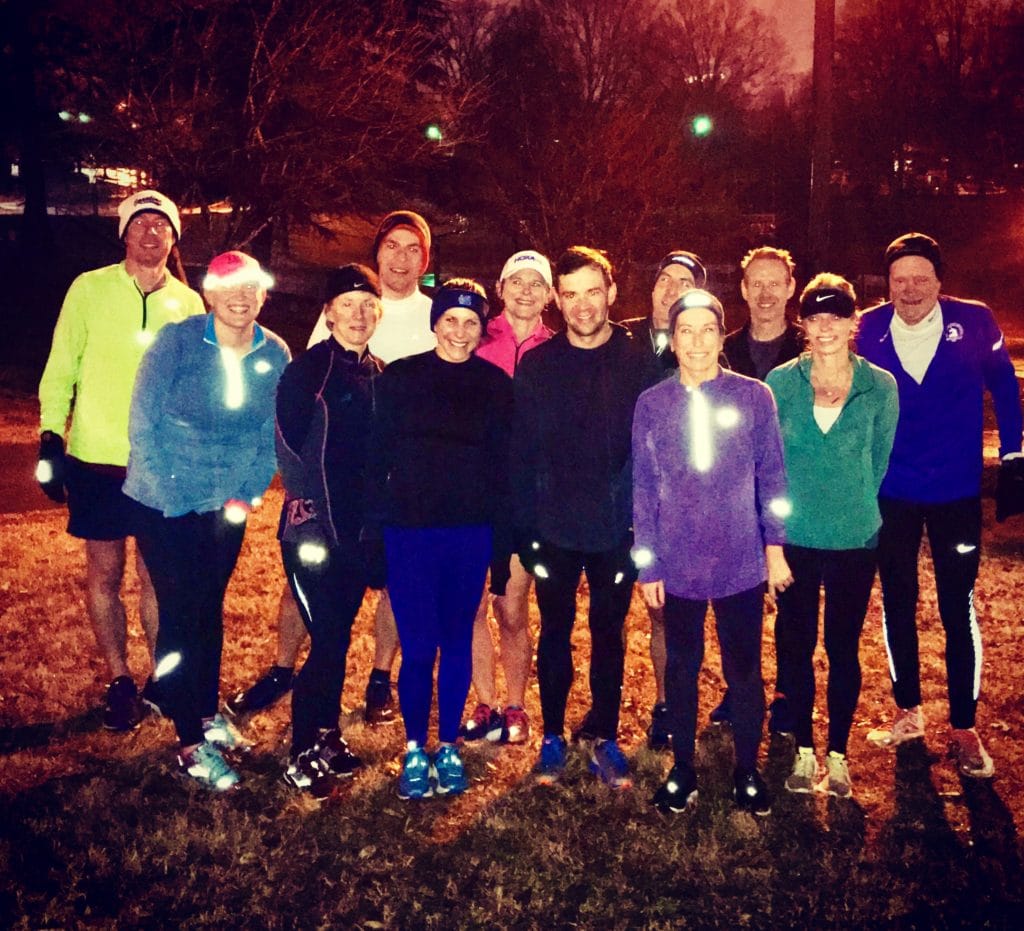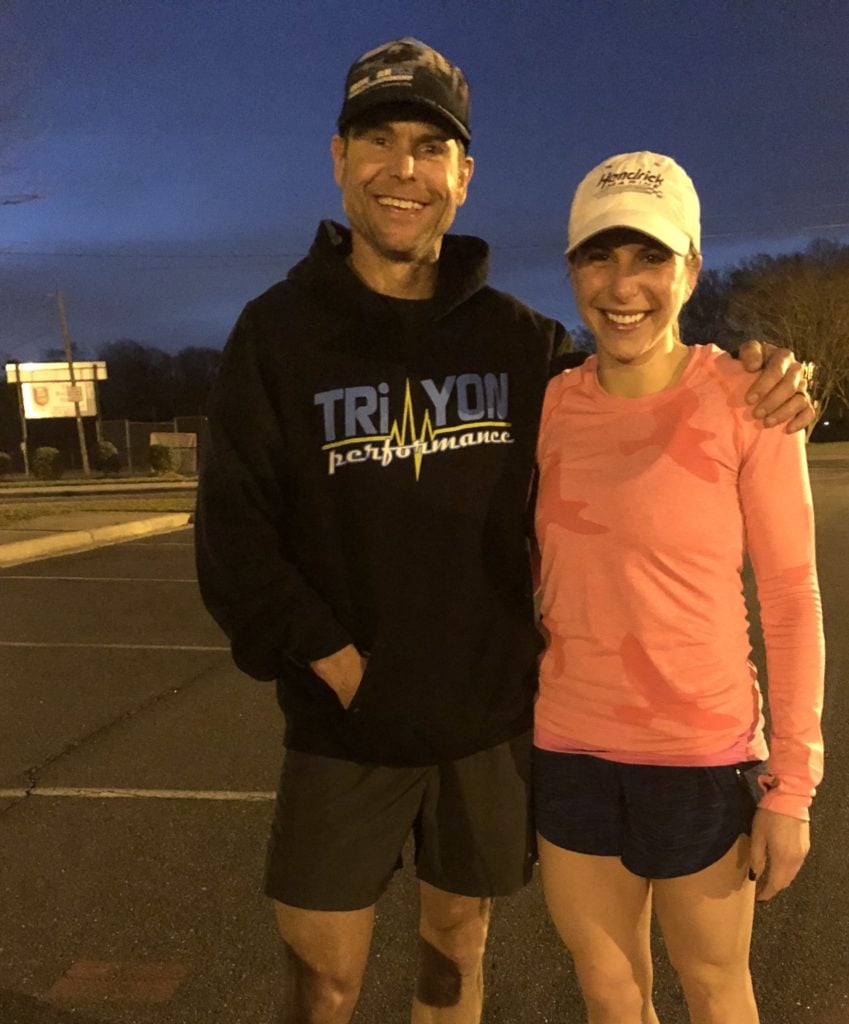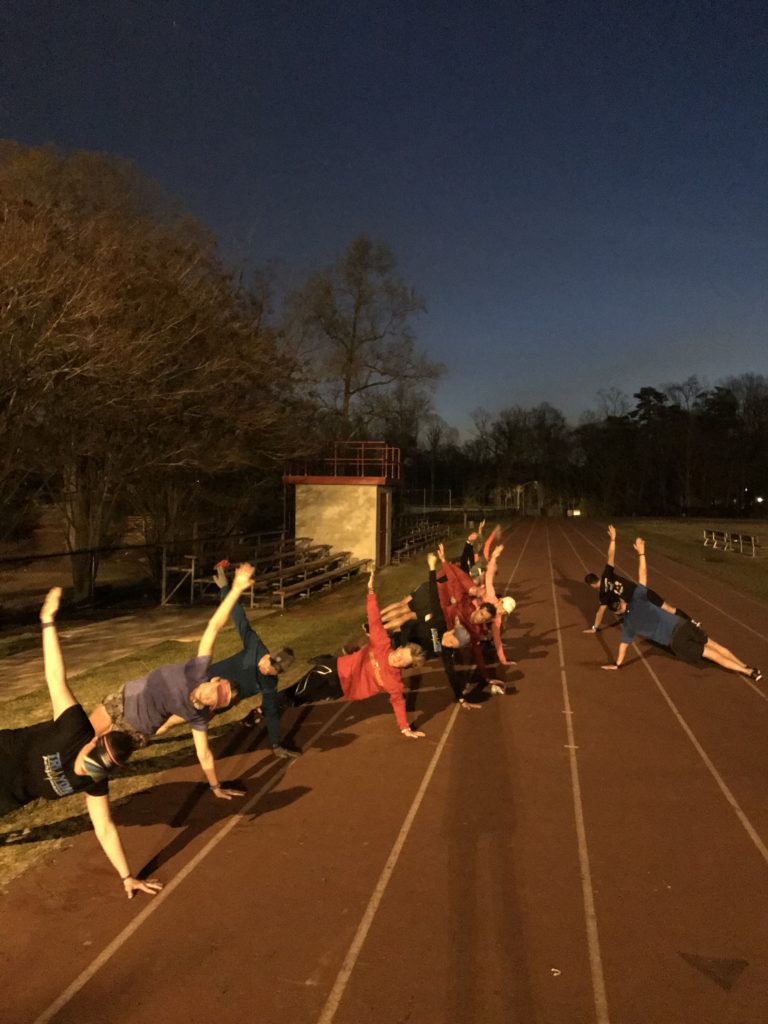One very dark, cool Wednesday morning in September, I walked onto the Alexander Graham Middle School track with 30 or so other runners. It was 5:30 in the morning. My mother would say that’s the middle of the night. A former high school cross-country runner and soccer player, I never competed on a track, never trained on a track and until last fall, avoided running on a track at all cost.
But that September morning, a herd of runners carried me around, and around, and around the AG track. I felt fast and strong and part of a team. Completely hooked from that moment on, I am fully committed to Wednesday speed workouts with team TriYon.
This pic was taken just after my very first track workout. Yes, Coach makes us plank after an hour of speed.
We alternate each week between the track, hill sprints, fartleks and other speed workouts. Coach Jamey Yon and the TriYon family show up in the rain, cold, snow, scorching temps and high humidity. They are relentless and dedicated runners and triathletes. They push me each week, and because of this team, I’ve discovered how hard I can truly push myself.
This was a freezing cold, rainy morning in January after running around Latta Park. It started snowing an hour later and we all stayed home from school and work, glad that we’d already crushed a workout that morning.
If you are like me, you run the same pace for pretty much every run unless it’s race day. Before my girl Cameron dragged me to the track that day, I didn’t know the difference between tempo runs, recovery runs, speedwork and interval training. I just went out and ran. And you know what? That worked for me. I successfully ran four marathons and over half a dozen half marathons training with that method.
But with Boston on the horizon and my PRs dropping with each race, I developed a new desire to improve as a runner and to see just how fast I can go. What have I learned? You gotta run fast to run fast.
That’s catchy, but really, you have to train fast at some point each week to improve your speed on race day. Coach encourages us to come out of our physical and mental comfort zones. He’ll tell you, if you want to see improvements, you have to experience a little discomfort. “To increase your speed and strength you have to add extra ‘stress’ on your muscular and cardiovascular systems. Introducing speedwork once a week is a great way to become a stronger, fitter, and faster runner.”
Thanks, Coach.
THE BENEFITS OF SPEED WORK
Faster, Stronger, Better
1. Faster. Your running pace will soon become faster at the same effort level as before you added speedwork. You’ll shave off a few seconds or minutes of your time and start hitting those PRs.
2. Stronger. Coach tells us that with proper nutrition, your muscular system will recover and grow stronger from the extra stress you put on your muscles, tendons, and ligaments. Your cardiovascular system will also recover and grow stronger from the greater demand you put on your lungs. The heart muscle will become larger and more efficient at pumping oxygen and vital nutrients through your blood. Plus, you burn more body fat during speed workouts and gain lean muscle tissue when you rest and recover. “It’s like a shot of caffeine for your metabolism!”
3. Better. Coach says that “if you currently run all your weekly miles in an aerobic ‘comfortable’ state, you can benefit greatly from adding 10-15% of your weekly total mileage in speedwork. Introducing anaerobic ‘uncomfortable’ running is best accomplished with a running partner or group. Somehow challenging runs or even challenging life situations are made easier with the support of others.” This is all good news for optimal health and wellness!
HOW DO I START?
Like Coach says, speedwork is best with a running partner or group. I cannot wait to exercise with my 30-40 runner friends every Wednesday. But you don’t need 30 people to practice speedwork. You can do it on your own or with one or two running buddies.
Before you hit the track, makeup your workout for the day. I was such a new track runner that I didn’t even know the track distances. Oops. 100 = the straight part of the track from corner to corner; 400 = once around the track; 800 = twice around; and 1 mile = 4 times around.
Here are a couple workouts to try:
Workout #1
Warm up (we usually run a mile around the neighborhood at a comfortable/recovery pace with a few pick-ups on the track before we start)
400 X 2
800 X 2
1 Mile
800 X 2
400 X 2
1 Mile
Cool down
Workout #2
Warm up
400 X 2
800 X 2
100 X 6
800 X 2
400 X 2
Cool down
You can play around with these distances, of course. This just gives you an idea. I suggest you plan your workout in advance of hitting the track.
You can also find a steep hill in your neighborhood and run up it at full speed 8 to 10 times with recovery on the downhill.
Takeaways:
You gotta run fast to run fast
Speedwork makes you faster, stronger, better
Grab a running partner and hit the track
I’m grateful for the TriYon crew and the speed they’ve helped me develop, and I’m confident that it will pay off in Boston.
Now, go get your speed!
See you out there.
H//




